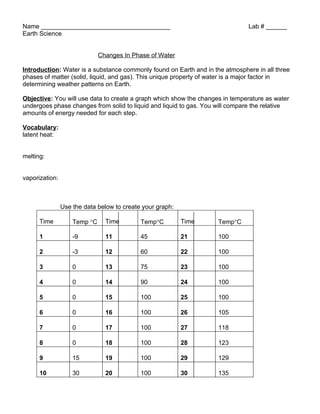
Phase change activity
- 1. Name _____________________________________ Lab # ______ Earth Science Changes In Phase of Water Introduction: Water is a substance commonly found on Earth and in the atmosphere in all three phases of matter (solid, liquid, and gas). This unique property of water is a major factor in determining weather patterns on Earth. Objective: You will use data to create a graph which show the changes in temperature as water undergoes phase changes from solid to liquid and liquid to gas. You will compare the relative amounts of energy needed for each step. Vocabulary: latent heat: melting: vaporization: Use the data below to create your graph: Time Temp °C Time Temp°C Time Temp°C 1 -9 11 45 21 100 2 -3 12 60 22 100 3 0 13 75 23 100 4 0 14 90 24 100 5 0 15 100 25 100 6 0 16 100 26 105 7 0 17 100 27 118 8 0 18 100 28 123 9 15 19 100 29 129 10 30 20 100 30 135
- 2. Discussion Questions: (please answer in Complete Sentences) 1. According to your graph during what period of time was the sample in the solid (ice) phase? (Label it on your graph) 2. According to your graph, did the temperature increase while the ice was melting? 3. According to your graph, what happened to the temperature of the water between the time the ice melted and the water boiled? 4. How long did it take for the solid water to completely change it’s phase to liquid water? 5. How long did it take the liquid water to completely change to water vapor? 6. Which phase change gained and released the most energy? 7. Calculate the rate of temperature change between 25 and 30 minutes: (show all work) Answer _______________°C/min. 8. From minute 15 to minute 25, what phase change was taking place? 9. In what phase was the sample from minute 26-minute 30? (label it on your graph)
- 3. Heat Curve of Water Temp °C Time (min) At what minute did the ice begin to melt _____________________ How many minutes did the ice take to melt _____________________ At what minute is the ice entirely melted _____________________ At what minute did the water begin to boil _____________________ How many minutes did the water take to boil ____________________